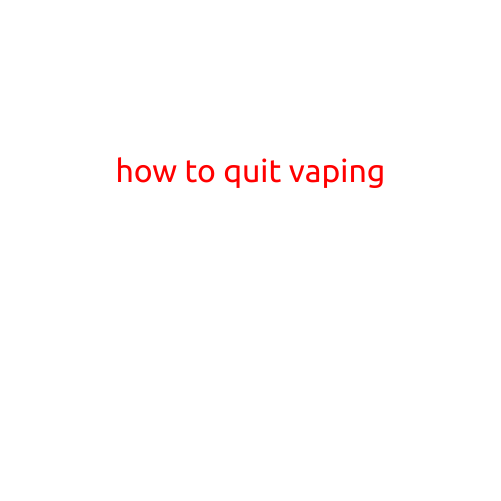
How to Quit Vaping: A Step-by-Step Guide
Vaping has become a widespread phenomenon, with millions of people around the world using e-cigarettes as a way to consume nicotine and other substances. However, the health risks associated with vaping are becoming increasingly clear, and many people are recognizing the need to quit vaping. Quitting can be a challenging process, but with the right strategies and support, it is possible to overcome the addiction and live a healthier, vape-free life.
Why Should You Quit Vaping?
Before we dive into the process of quitting vaping, it’s essential to understand the reasons why you should quit. Vaping can lead to:
- Respiratory problems: Vaping has been linked to respiratory issues such as bronchitis, chronic coughing, and in some cases, lung disease.
- Nicotine addiction: Vaping devices often contain nicotine, which is a highly addictive substance that can lead to physical dependence and withdrawal symptoms.
- Increased risk of heart disease: Research has shown that vaping can increase the risk of heart disease and stroke, particularly in young people.
- Cost: Vaping can be expensive, with many people spending hundreds of dollars each month on e-liquids and devices.
Step 1: Prepare to Quit
Before you start the quitting process, it’s essential to prepare yourself mentally and physically. Here are some tips to help you prepare:
- Set a quit date: Choose a specific date to quit vaping and mark it on your calendar.
- Identify your triggers: Take note of the situations, emotions, and people that trigger your desire to vape.
- Get rid of your vaping devices: Dispose of your e-cigarettes, vape pens, and other vaping devices to avoid temptation.
- Find healthy alternatives: Replace vaping with healthier habits, such as exercise, meditation, or hobbies.
Step 2: Manage Nicotine Withdrawal
Nicotine is a highly addictive substance, and quitting vaping can lead to withdrawal symptoms such as:
- Irritability: Feeling anxious, restless, or agitated.
- Cravings: Strong urges to vape.
- Fatigue: Feeling tired or sluggish.
- Insomnia: Difficulty sleeping.
To manage these symptoms, you can:
- Use nicotine replacement therapy: Products like gum, lozenges, or patches can help reduce cravings and withdrawal symptoms.
- Try non-nicotine prescription medications: Prescription medications like bupropion (Zyban) or varenicline (Chantix) can help reduce cravings and withdrawal symptoms.
- Stay hydrated: Drink plenty of water and other fluids to help flush out your system.
- Get support: Share your struggles with friends, family, or a support group to get emotional support.
Step 3: Stay on Track
Quitting vaping is a journey, and it’s essential to stay committed and motivated. Here are some tips to help you stay on track:
- Track your progress: Keep a journal or use an app to track your progress, set reminders, and receive motivational messages.
- Stay busy: Engage in activities that distract you from cravings and withdrawal symptoms.
- Reward yourself: Celebrate small milestones, such as reaching a week without vaping, with non-vaping rewards, such as a movie night or a new outfit.
- Seek professional help: If you’re struggling to quit, consider seeking help from a counselor or a therapist who can provide guidance and support.
Conclusion
Quitting vaping is a challenging process, but with the right strategies and support, it is possible to overcome the addiction and live a healthier, vape-free life. By preparing yourself mentally and physically, managing nicotine withdrawal symptoms, and staying on track, you can overcome the hurdles and achieve your goal. Remember, quitting vaping is a journey, and it’s essential to be patient, persistent, and kind to yourself throughout the process.





